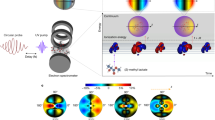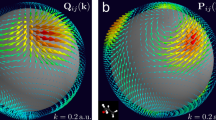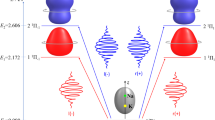Abstract
Chiral molecules that are non-superimposable mirror images of each other, known as enantiomers, have identical chemical and physical properties unless they interact with another chiral entity, such as chiral light. Chiroptical1 effects arising from such interactions are used to detect enantiomers in mixtures and to induce enantioselective synthesis and catalysis. Chiroptical effects often arise from the interplay between light-induced electric- and magnetic-dipole transitions in a molecule and evolve on ultrafast electronic timescales. Here we use high-harmonic generation2,3 from a randomly oriented gas of molecules subjected to an intense laser field, to probe chiral interactions on these sub-femtosecond timescales. We show that a slight disparity in the laser-driven electron dynamics in the two enantiomers is recorded and amplified by several orders of magnitude in the harmonic spectra. Our work shows that chiroptical detection can go beyond detecting chiral structure4,5,6,7 to resolving and controlling chiral dynamics on electronic timescales.
This is a preview of subscription content, access via your institution
Access options
Subscribe to this journal
Receive 12 print issues and online access
$259.00 per year
only $21.58 per issue
Buy this article
- Purchase on SpringerLink
- Instant access to full article PDF
Prices may be subject to local taxes which are calculated during checkout




Similar content being viewed by others
References
Berova, N., Polavarapu, P. L., Nakanishi, K. & Woody, R. W. (eds) Comprehensive Chiroptical Spectroscopy Vol. 1 (Wiley, 2012).
Ferray, M. et al. Multiple-harmonic conversion of 1064 nm radiation in rare gases. J. Phys. B 21, L31–L35 (1988).
Corkum, P. B. Plasma perspective on strong field multiphoton ionization. Phys. Rev. Lett. 71, 1994–1997 (1993).
Herwig, P. et al. Imaging the absolute configuration of a chiral epoxide in the gas phase. Science 342, 1084–1086 (2013).
Jiang, J. et al. Observation of possible topological in-gap surface states in the Kondo insulator SmB6 by photoemission. Nature Commun. 4, 3010 (2013).
Pitzer, M. et al. Direct determination of absolute molecular stereochemistry in gas phase by Coulomb explosion imaging. Science 341, 1096–1100 (2013).
Patterson, D., Schnell, M. & Doyle, J. M. Enantiomer-specific detection of chiral molecules via microwave spectroscopy. Nature 497, 475–477 (2013).
Schafer, K. J., Yang, B., DiMauro, L. F. & Kulander, K. C. Above threshold ionization beyond the high harmonic cutoff. Phys. Rev. Lett. 70, 1599–1602 (1993).
Popmintchev, T. et al. Bright coherent ultrahigh harmonics in the keV X-ray regime from mid-infrared femtosecond lasers. Science 336, 1287–1291 (2012).
Baker, S. et al. Probing proton dynamics in molecules on an attosecond time scale. Science 312, 424–427 (2006).
Doumy, G. et al. Attosecond synchronization of high-order harmonics from midinfrared drivers. Phys. Rev. Lett. 102, 093002 (2009).
Fischer, P. & Hache, F. Nonlinear optical spectroscopy of chiral molecules. Chirality 17, 421–437 (2005).
Rhee, H. et al. Femtosecond characterization of vibrational optical activity of chiral molecules. Nature 458, 310–313 (2009).
Abderhalden, E. & Eichwald, E. Über optisch-aktives Propylenglykol und optisch-aktive β-Oxy-buttersäure. Ber. Dtsch. Chem. Ges. 51, 1312–1322 (1918).
Bouchardat, G. & Lafont, J. Synthetical isoborneols; their identity with the fenchylic alcohols. C. R. Hebd. Seances Acad. Sci. 126, 755–757 (1898).
Turchini, S. et al. Circular dichroism in photoelectron spectroscopy of free chiral molecules: Experiment and theory on methyl-oxirane. Phys. Rev. A 70, 014502 (2004).
Stranges, S. et al. Valence photoionization dynamics in circular dichroism of chiral free molecules: The methyl-oxirane. J. Chem. Phys. 122, 244303 (2005).
Stener, M., Fronzoni, G., Di Tommaso, D. & Decleva, P. Density functional study on the circular dichroism of photoelectron angular distribution from chiral derivatives of oxirane. J. Chem. Phys. 120, 3284–3296 (2004).
Garcia, G. A., Nahon, L., Daly, S. & Powis, I. Vibrationally induced inversion of photoelectron forward–backward asymmetry in chiral molecule photoionization by circularly polarized light. Nature Commun. 4, 2132 (2013).
Powis, I., Harding, C. J., Garcia, G. A. & Nahon, L. A valence photoelectron imaging investigation of chiral asymmetry in the photoionization of fenchone and camphor. ChemPhysChem 9, 475–483 (2008).
Ulrich, V. et al. Giant chiral asymmetry in the C 1s core level photoemission from randomly oriented fenchone enantiomers. J. Phys. Chem. A 112, 3544–3549 (2008).
Lux, C. et al. Circular dichroism in the photoelectron angular distributions of camphor and fenchone from multiphoton ionization with femtosecond laser pulses. Angew. Chem. Int. Ed. 51, 5001–5005 (2012).
Torres, R. et al. Extension of high harmonic spectroscopy in molecules by a 1300 nm laser field. Opt. Express 18, 3174–3180 (2010).
Ivanov, M. Y., Brabec, T. & Burnett, N. Coulomb corrections and polarization effects in high-intensity high-harmonic emission. Phys. Rev. A 54, 742–745 (1996).
Kroener, D. Chiral distinction by ultrashort laser pulses: Electron wavepacket dynamics incorporating magnetic interactions. J. Phys. Chem. A 115, 14510–14518 (2011).
Mairesse, Y. et al. High harmonic spectroscopy of multichannel dynamics in strong-field ionization. Phys. Rev. Lett. 104, 213601 (2010).
Kimura, K., Katsumata, S., Achiba, Y., Yamazaki, T. & Iwata, S. Handbook of He I Photoelectron Spectra of Fundamental Organic Molecules (Japan Scientific Societies Press, 1981).
Smirnova, O. et al. High harmonic interferometry of multi-electron dynamics in molecules. Nature 460, 972–977 (2009).
Cundiff, S. T. & Weiner, A. M. Optical arbitrary waveform generation. Nature Photon. 4, 760–766 (2010).
Xie, X. et al. Internal momentum state mapping using high harmonic radiation. Phys. Rev. Lett. 101, 033901 (2008).
Budil, K. S., Salières, P., Perry, M. D. & L’Huillier, A. Influence of ellipticity on harmonic generation. Phys. Rev. A 48, R3437–R3440 (1993).
Sukiasyan, S., Patchkovskii, S., Smirnova, O., Brabec, T. & Ivanov, M. Exchange and polarization effect in high-order harmonic imaging of molecular structures. Phys. Rev. A 82, 043414 (2010).
Patchkovskii, S., Zhao, Z., Brabec, T. & Villeneuve, D. M. High harmonic generation and molecular orbital tomography in multielectron systems. J. Comput. Phys. 126, 114306 (2007).
Smirnova, O., Spanner, M. & Ivanov, M. Analytical solutions for strong field-driven atomic and molecular one- and two-electron continua and applications to strong-field problems. Phys. Rev. A 77, 033407 (2008).
Smirnova, O. et al. Attosecond circular dichroism spectroscopy of polyatomic molecules. Phys. Rev. Lett. 102, 063601 (2009).
Huang, S. W. & Carrington, T. A comparison of filter diagonalisation methods with the Lanczos method for calculating vibrational energy levels. Chem. Phys. Lett. 312, 311–318 (1999).
Suarez, J., Farantos, S. C., Stamatiadis, S. & Lathouwers, L. A method for solving the molecular Schrödinger equation in cartesian coordinates via angular momentum projection operators. Comput. Phys. Commun. 180, 2025–2033 (2009).
Kosloff, R. Dynamics of Molecules and Chemical Reactions 185–230 (CRC Press, 1996).
Burnett, K., Reed, V. C., Cooper, J. & Knight, P. L. Calculation of the background emitted during high-harmonic generation. Phys. Rev. A 45, 3347–3349 (1992).
Smirnova, O. & Ivanov, M. Attosecond and XUV Physics: Ultrafast Dynamics and Spectroscopy Ch. 7, 201–256 (Wiley-VCH, 2014).
Lewenstein, M., Balcou, P., Ivanov, M. Y., L’Huillier, A. & Corkum, P. B. Theory of high-harmonic generation by low-frequency laser fields. Phys. Rev. A 49, 2117–2132 (1994).
Shafir, D. et al. Resolving the time when an electron exits a tunneling barrier. Nature 485, 343–346 (2012).
Chirilǎ, C. C., Kylstra, N. J., Potvliege, R. M. & Joachain, C. J. Nondipole effects in photon emission by laser-driven ions. Phys. Rev. A 66, 063411 (2002).
Spanner, M. & Patchkovskii, S. One-electron ionization of multielectron systems in strong nonresonant laser fields. Phys. Rev. A 80, 063411 (2009).
Acknowledgements
Experiments on epoxypropane were performed at Advanced Laser Light Source in Montreal. We thank A. Laramée and F. Poitras for their technical expertise. Experiments on fenchone were performed at CELIA, Université de Bordeaux, Talence. We thank E. Constant, E. Cormier and E. Mével for providing key apparatus used in the experiment. We thank M. Y. Ivanov, L. Nahon and M. Spanner for fruitful discussions. We acknowledge financial support from Natural Science and Engineering Research Council of Canada, Canadian Foundation for Innovation, Canada Research Chairs, FRQNT, MDEIE, CIPI, CFI, ANR (ANR-08-JCJC-0029 HarMoDyn), the Conseil Regional d’Aquitaine (20091304003 ATTOMOL and 2.1.3-09010502 COLA2), the European Union (Laserlab), the European COST Action CM1204 XLIC, the EU Marie Curie ITN network CORINF, Grant Agreement No. 264951, and the support of Einstein foundation project A-211-55 Attosecond Electron Dynamics.
Author information
Authors and Affiliations
Contributions
R.C. and A.E.B. contributed equally to the experimental work. A.E.B. and V.R.B. designed experiments on epoxypropane and analysed the data; A.E.B., M.C.H.W. and A.F.A., in collaboration with B.E.S., N.T. and F.L., performed experiments on epoxypropane at ALLS. R.C., B.F., A.F., J.H., H.R., N.T., V.B. and Y.M. designed, conducted and analysed the fenchone measurements. D.D. and S.Petit operated the laser system at CELIA. J.S. and B.P. performed the TDSE calculations for the model chiral molecules and analysed the type-I mechanism of cHHG. S.Patchkovskii proposed and analysed the type-I mechanism of cHHG and performed quantum chemical calculations for epoxypropane and fenchone. O.S. proposed and analysed the type-II mechanism of cHHG and the reconstruction of the time-dependent chiral response. All authors contributed to writingthe manuscript.
Corresponding authors
Ethics declarations
Competing interests
The authors declare no competing financial interests.
Supplementary information
Supplementary Information
Supplementary Information (PDF 1327 kb)
Rights and permissions
About this article
Cite this article
Cireasa, R., Boguslavskiy, A., Pons, B. et al. Probing molecular chirality on a sub-femtosecond timescale. Nature Phys 11, 654–658 (2015). https://doi.org/10.1038/nphys3369
Received:
Accepted:
Published:
Issue date:
DOI: https://doi.org/10.1038/nphys3369
This article is cited by
-
Capturing electron-driven chiral dynamics in UV-excited molecules
Nature (2024)
-
Attosecond-resolved non-dipole photoionization dynamics
Nature Photonics (2024)
-
Nonlinear helical dichroism in chiral and achiral molecules
Nature Photonics (2023)
-
Orbital perspective on high-harmonic generation from solids
Nature Communications (2023)
-
Extracting sub-cycle electronic and nuclear dynamics from high harmonic spectra
Scientific Reports (2021)



